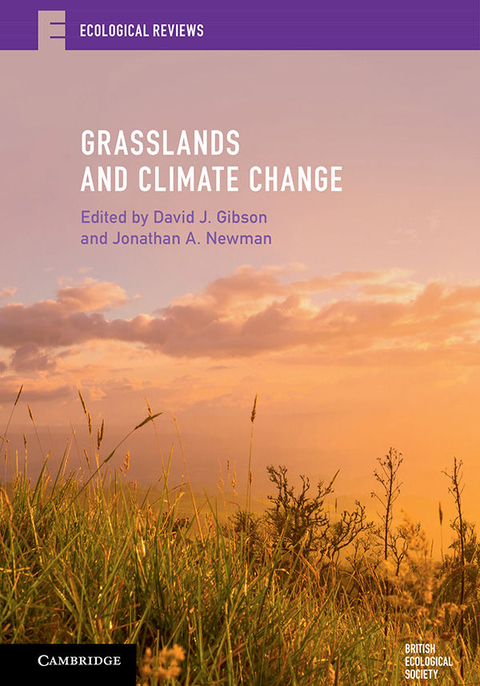
Grasslands and Climate Change
Cambridge University Press (Verlag)
978-1-316-64677-9 (ISBN)
Grasslands are the most extensive terrestrial biome on Earth and are critically important for forage, biodiversity, and ecosystem services. This book brings together an international team of researchers to review scientific knowledge of the effects of climate change on world grasslands, a process we are only just starting to understand. Part I assesses how climate change will impact on the distribution of grasslands, as well as production, biogeochemical cycling and ecosystem services. Part II considers the consequences for the spread of invasive species, demographic change, trophic-level relationships, soil biota, and evolutionary change within grassland biodiversity. Part III proposes how ecologists can respond to climate change effects, focusing on grazing systems, cultural ecology, range management, and restoration. The concluding chapter sets grasslands in the context of the Anthropocene era and identifies the vital research and conservation needs for grassland ecosystems to remain environmentally sustainable under climate change.
David J. Gibson FRSB is Distinguished Professor of Plant Biology, Southern Illinois University, Carbondale. He is the Executive Editor of the Journal of Ecology, the Editor-in-Chief of Oxford Bibliographies in Ecology, and has written two books, Grasses and Grassland Ecology (2008) and Methods in Comparative Plant Population Ecology (2nd edition, 2014). Jonathan A. Newman is Dean of the College of Biological Science, University of Guelph, Ontario, where he was also the founding Director of the School of Environmental Sciences and Chair of the Department of Environmental Biology. He is the lead author of Climate Change Biology (2011) and Defending Biodiversity (Cambridge, 2017) and has published more than 100 scientific journal articles.
Introduction: 1. Grasslands and climate change: an overview David J. Gibson and Jonathan A. Newman; 2. Methodology I: detecting and projecting grassland change from plots to the landscape Heather Hager and Jonathan A. Newman; 3. Methodology II: remote sensing and modelling Geoffrey Henebry; Part I. Grassland Dynamics and Climate Change: 4. Projected climate change in global grasslands Mike B. Jones; 5. Production changes in response to climate change Lauchlan Fraser; 6. Will climate change push grasslands past tipping points? Zak Ratajczak and Laura Ladwig; 7. Biochemical cycling in grasslands under climate change Hugh Henry; 8. Climate change effects on grassland ecosystem services Sandra Lavorel; Part II. Species Traits, Functional Groups, and Evolutionary Change: 9. Grassland invasion in a changing climate Jane A. Catford and Lizzie P. Jones; 10. How global change drives demography in grasslands Johan Ehlrén; 11. Impacts of climate change on trophic interactions in grasslands Sue E. Hartley and Colin Beale; 12. Grassland belowground feedbacks and climate change Richard D. Bardgett and Marina Semchenko; 13. Keeping up: climate driven evolutionary change, dispersal, and migration Kathryn A. Yurkonis and William Harris; 14. The future biogeography of C3 and C4 grasslands Elisabeth J. Forrestel and Erika J. Edwards; Part III. Dealing with Climate Change Effects: 15. Altered grazing systems: pastoralism to conventional agriculture Phillip K. Thornton, Mario Herrero and Randall B. Boone; 16. Climate change and the politics and science of traditional grassland management Michael R. Dove; 17. Assessing rangeland health under climate variability and change John Bradford, Mike Duniway and Seth Munson; 18. Restoring grassland in the context of climate change Sara G. Baer, David J. Gibson and Loretta C. Johnson; 19. Grasslands in the Anthropocene: research and conservation needs David J. Gibson and Jonathan A. Newman; Index.
| Erscheinungsdatum | 22.03.2019 |
|---|---|
| Reihe/Serie | Ecological Reviews |
| Zusatzinfo | Worked examples or Exercises; 18 Tables, black and white; 32 Halftones, black and white; 14 Line drawings, black and white |
| Verlagsort | Cambridge |
| Sprache | englisch |
| Maße | 175 x 247 mm |
| Gewicht | 790 g |
| Themenwelt | Naturwissenschaften ► Biologie ► Ökologie / Naturschutz |
| Naturwissenschaften ► Geowissenschaften ► Geografie / Kartografie | |
| Naturwissenschaften ► Geowissenschaften ► Meteorologie / Klimatologie | |
| ISBN-10 | 1-316-64677-7 / 1316646777 |
| ISBN-13 | 978-1-316-64677-9 / 9781316646779 |
| Zustand | Neuware |
| Haben Sie eine Frage zum Produkt? |
aus dem Bereich


